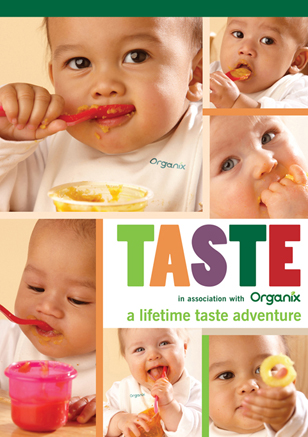publication date: Mar 19, 2011

It takes
time for
babies to learn to appreciate lots of different
food tastes and
textures. Around the
six month mark,
babies naturally enter a
phase that makes this
process possible.
Organix calls
it "the
weaning window" – it's the
strongest time for
learning about
new tastes and helping to shape your child's
healthy diet.
Babies naturally prefer sweet flavours, such as
breast milk. All other
taste preferences are
learned and adapted by exposure
throughout
infancy. The type of
food offered in
infancy seems to predict
foods that will still be in your little one's
diet
later in
childhood. Research also
highlights a
sensitive period for the introduction of
textured foods.
Teach your
baby how to love different tastes and textures with these top tips from TASTE:
- Dr Gillian Harris,
Consultant Paediatric Psychologist,
says, "Offer your baby a wide variety of flavours early on. In early infancy it takes very few
exposures to learn to like new tastes - in toddlers it may take up to 14
exposures to learn to like a food".
-
Make life easier on yourself and start your baby on
the tricky foods early. Gillian says, "Bitter tasting foods, like broccoli, are more difficult for your baby to
learn to accept. However, even
difficult tastes like this can eventually be well accepted if introduced
early."
-
Keep offering
your baby tastes and textures previously rejected. Paediatric Dietician
Judy More advises, "Give your baby plenty of chances to learn to like a
food".
-
Even
food that has been accepted before might be rejected because it looks different,
such as a biscuit that's broken.
Most children will grow out of this response, so don't worry.
- Dr Frankie
Phillips, Nutritional Advisor to Organix, advises, "Let carrots taste of carrots. It's best to
avoid masking or disguising the taste - you'll want your baby to recognise the
real food being offered."
-
Judy advises, "Keep offering soft finger foods at each meal, this will also help your
baby learn to deal with lumps. If your baby bites a larger lump than they can
mange to swallow, they will gag it back. This is different to choking and is
part of the learning process".
-
Don't worry about teeth – it doesn't matter how many teeth your baby
has, babies use their gums for chewing. If your baby spits lumps out, don't worry, just keep trying. "Don't revert to food without lumps as
your baby needs the practice," says Judy.
- "Give your baby a spoon to play with,"
suggests Judy. It'll help keep
your baby interested at mealtime.
And encourage your little one to touch food. "Your baby learns about
food through touch as well as sight and taste," says Judy.
-
Look out for
likes and dislikes. While
encouraging your baby to enjoy a wide variety of tastes and textures, keep an
eye out for patterns that help them to enjoy their food more – eating one food
at a time, or liking certain flavours mixed together.
-
Offer two courses: from about seven to eight months
giving your baby two courses at mealtimes gives you the chance to introduce a
wider range of foods.
Download a
free copy of TASTE at
https://www.organix.com/taste
 It takes
time for babies to learn to appreciate lots of different food tastes and
textures. Around the six month mark,
babies naturally enter a phase that makes this process possible. Organix calls
it "the weaning window" – it's the
strongest time for learning about new tastes and helping to shape your child's
healthy diet.
It takes
time for babies to learn to appreciate lots of different food tastes and
textures. Around the six month mark,
babies naturally enter a phase that makes this process possible. Organix calls
it "the weaning window" – it's the
strongest time for learning about new tastes and helping to shape your child's
healthy diet.